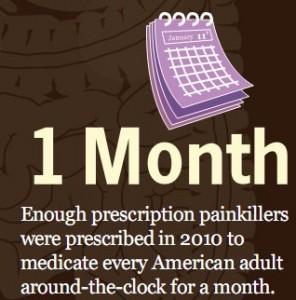
According to the Center for Disease and Control, enough prescription painkillers were prescribed in 2010 to medicate every American adult around-the-clock for a month. While prescription painkillers were initially formulated to help people cope with pain—in today’s day and age, more and more people are using them to get high.
Considering that the quantity of prescription painkillers sold to pharmacies, hospitals, and doctor’s offices was four times larger in 2010 than in 1999, it’s no surprise that more and more prescription painkiller overdoses are occurring. Looking at it from a world view, the United States consumes over 80 percent of the world’s opium which is the active ingredient in painkillers, however we only have 4.6 percent of the world’s population.
According to the Los Angeles Times, drug deaths now outnumber traffic fatalities in the United States. One of the problems concerning prescription painkillers is how easy they are to get ahold of. Doctors are far too eager to write prescriptions for painkillers to help patients cope with pain.
Many doctors fail to take into consideration whether patients who are prescribed painkillers will become addicted to them. When doctors fail to look at the full medical history of a patient and whether the patient has a susceptibility to addiction, they are putting the patient’s health at risk.
Another problem concerning prescription painkillers is the relaxed attitude people have about taking them. Since they are prescribed by a doctor, people are under the faulty assumption that they are safer to take, and less addictive, unlike many of the illicit drugs sold on the streets.
So, who is to blame? When it comes to who is responsible for the rising number of prescription painkiller overdoses—more than one culprit is involved. Many overly aggressive pharmaceutical companies make false claims about their products and use psychological tactics to convince doctors how their patients can greatly benefit from using these pharmaceutical drugs.
However, the doctor’s office isn’t the only place where prescription painkillers are easily obtained. According to the National Household Survey on Drug Use and Health (NHSDUH), an annual survey that includes information from interviews with thousands of people about their drug habit, most opioid painkillers are obtained from family or friends, over 69% do not get their painkillers from medical sources, but from family or friends.
Even though the majority of users get their painkillers from family and friends, the finger still points back to pharmaceutical companies and doctors who are allowing so many of these deadly drugs in the hands of people. For a non abuser who has had any surgery in the last year, most have a bottle of oxy sitting in the medicine cabinet which can easily be stolen by someone visiting your home or given to a friend who asks for them.
Prescription drugs are one of the top drugs of choice for high school students because they are easier to obtain than both marijuana and alcohol since they can be found at home. One of the new late night party trends taking place in cities throughout the United States are parties known as pharm parties. Pharm parties are parties where teenagers experiment with any number of prescription medications to obtain a high. Combine taking prescription painkillers with heavy alcohol consumption and you have a deadly cocktail of controlled substances—that can kill a person.
Many people fail to consider just how addictive and deadly prescription painkillers can be. According to the Center for Disease Control prescription overdose deaths have tripled in the last decade, with 40 people dying every day.
Prescription painkillers are easily attainable by just about anyone, regardless of age or socioeconomic status. Doctors and healthcare professionals need to stop prescribing prescription painkillers to every patient who complains about pain and limit the number of pills in each prescription. The healthcare industry needs to take an active role in educating each patient about the potential dangers of prescription drug abuse and actively limit the supply given to a patient. Until then, more and more prescription overdoses will occur and more people will die from this growing form of drug abuse.